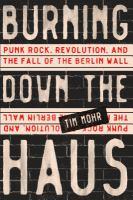
Using research from interviews, archives and declassified Stasi files, Mohr puts together a timeline from the appearance of the first East German punk up to the dismantling of the GDR. Although world events and politics played a huge role in the fall of the wall, the East German punks’ grassroots efforts to expose the oppressiveness of their government got regular citizens involved, ultimately tipping the scales. In the beginning (early 80’s) there was only a small and scattered group of punks, but as their numbers started to grow, unlikely partnerships with progressive pastors of the Lutheran church gave them a safe space to network, organize and give voice to their ideas, especially through music. The punks used the aggressiveness of their music and lyrics to speak out against the regime. Through their close-knit network, they were able to produce and share music and literature and help each other stay safe and out of prison.
Mohr’s telling of punk’s influence on the fall of the GDR is full of interesting facts and anecdotes, but can sometimes read like a list of people and events. It is the personal stories of the punks that drew me in and made the book worth reading. He starts out well by opening with an introduction to the first ever punk in East Berlin, a 15 year old girl named Major. Right off, I was invested in Major’s surprising story. As a punk, she and others like her were a target for constant harassment, arrest and brutality by the authorities and other citizens. We get to know a few more key players – some came to punk for the music, some for the lifestyle and others for the politics, but all were considered (by the government) political agitators and enemies to society. Many were disowned by their parents and barred from finding employment or housing; all while only just teenagers. While the author spends time and care on the punks’ stories in the early chapters, Burning Down the Haus begins to lose me a bit in later chapters by introducing new characters too quickly and briefly, but I appreciate the unique perspective on a major world event. For other, similar perspectives on East Germany and the Berlin wall, try the book Berlin Calling or DVD Rockin’ the Wall.
